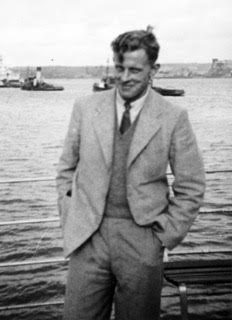East Budleigh's maypole, Thomas Morton and Merrymount
It’s not so long ago that the tradition of maypole dancing was revived in East Budleigh. An ancient English tradition which Roger Conant’s family would have enjoyed? Unlikely. In the increasingly puritanical England of the 1640s, maypoles were condemned by the Long Parliament as ‘a Heathenish vanity, generally abused to superstition and wickedness’, and were banned outright, along with Christmas and other ‘ungodly’ practices.
Well before then, Roger would have had problems had he tried to introduce it in New England at the settlement of Naumkeag, later to become Salem. With the arrival of Governor John Endicott and ‘godly’ Puritans in Naumkeag in 1628, such ‘pagan’ practices were viewed with horror. Shocking news was received by Puritan leaders around that time of May Day events taking place just over 20 miles away from Plymouth Colony, in the settlement once called Merrymount and now known as the town of Quincy.
Governor William Bradford in his History of Plimoth Plantation, records his disgust on learning that the inhabitants had ‘set up a May-pole, drinking and dancing about it many days together, inviting the Indian women for their consorts, dancing and frisking together (like so many fairies, or furies rather) and worse practices’. It was, he wrote, ‘as if they had anew revived & celebrated the feasts of ye Roman Goddess Flora, or ye beastly practices of ye mad Bacchanalians’. Morton was vilified by Bradford as a ‘lord of misrule’ who ‘maintained (as it were) a schoole of Athisme’.
Roger Conant is celebrated for his peaceful and friendly relationship with the indigenous people of New England. He was, according to sculptor Sir Henry Hudson Kitson who created the statue of Salem’s founder, ‘one of the very few among America's early settlers who was ever looked upon by the Indians as their true and staunch friend’. Even more renowned for his friendships with Native Americans, Thomas Morton, founder of Merrymount, stands out as a complex and flamboyant figure. The May Day festivities infuriated the Plymouth Puritans, not just because the Merrymount colonists were encouraging sexual relations between Europeans and Native Americans but also because Merrymount’s growing prosperity was seen as threatening the Puritans’ trade monopoly.
When even more extravagant May Day celebrations took place around an 80-foot maypole a military offensive against the colony was led in June 1628 by Captain Myles Standish. The maypole was chopped down. Morton was arrested and put in the stocks in Plymouth before being put on trial and marooned on one of the deserted Isles of Shoals, off the coast of New Hampshire. He could have starved to death on the island had it not been for friendly Indians from the mainland who supplied him with food. Eventually he was able to escape to England. When he returned to America he was arrested and appeared before the Massachusetts Bay Court, on 7 September, 1630, before being shipped back to England where he spent a short spell in jail.
Furious with his treatment, in 1635 Morton successfully sued the Massachusetts Bay Company, the political power behind the Plymouth Puritans. Two years later, in 1637, he published his three-volume New English Canaan, a broadside against the Plymouth Puritans. It was, according to an article published by the New England Historical Society, ‘a witty composition that praised the wisdom and humanity of the Indians and mocked the Puritans’. Morton described how in America he had encountered ‘two sortes of people, the one Christians, the other Infidels; these I found most full of humanity, and more friendly then the other.’ The New English Canaan became what is probably the first book to be banned in what is now the USA.
In our modern, liberal era there are those taking a more favourable view of Morton. Wikipedia’s profile of Merry Mount’s founder describes him as a ‘social reformer known for studying Native American culture’, and in recent times there have been plenty of more colourful opinions. ‘Today, people might call him America’s first hippie,’ writes the author of the New England Historical Society’s article quoted above. ‘Had it not been for his May Day party with a giant Maypole, Thomas Morton might have established a New England colony more tolerant, easygoing and fun than the one his dour Puritan neighbors created at Plymouth Plantation.’
American writer Ed Simon, in an article published in The Public Domain Review of 24 November 2020, goes even further. ‘The utopian Merrymount, it has long been argued, was a society built upon privileging art and poetry over industriousness and labor, and pursued a policy of intercultural harmony rather than white supremacy,’ he claims. The site of Merrymount, now an industrial area, ‘once bore witness to a strange and beautiful alternative dream of what America could have been.’
In 2011, Governor Deval Patrick proclaimed May 1 ‘Thomas Morton Day’ in Massachusetts, recognizing the achievements of Merrymount’s founder. For many Americans, the event was long overdue: it had been planned, as historian Dr Jack Dempsey writes, ‘in honor of this intrepid and good-humored Englishman who made a success of his trading post by treating Native Americans with respect’.
Pictured is a photo of May Day in East Budleigh, along with a page of the New English Canaan, and a copy of Governor Deval Patrick’s proclamation, reproduced by Dr Jack Dempsey, who has edited the New English Canaan.
If you are interested in the history of early America, and Roger Conant as a peacemaker in troubled times you can join the Devon Peacemaker Festival Facebook group at




Comments
Post a Comment